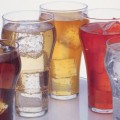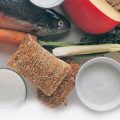Shake Off The Salt
By Amy Campbell MS, RD, CDE
Has your health care provider or dietitian told you to cut back on your sodium intake? If so, you’re not alone. According to the Centers for Disease Control and Prevention (CDC), most Americans eat more than twice as much sodium as is recommended.
WHAT IS SODIUM?
Sodium is a mineral the body needs in order to keep all the fluids in the body in the right amounts. We also need sodium for proper nerve and muscle function.
WHY IS TOO MUCH SODIUM HARMFUL?
Too much sodium can increase your risk for getting high blood pressure, which is a major risk factor for heart disease and stroke. People with diabetes are more likely to have high blood pressure and heart disease than people without diabetes, so cutting back on sodium is a good idea.
HOW MUCH SODIUM SHOULD I EAT?
The Dietary Guidelines for Americans recommend no more than 2,300 mg of sodium each day. That’s the amount of sodium in 1 teaspoon of salt. But some people may need to take in even less than 2,300 mg of sodium daily. For example, people who have high blood pressure, congestive heart failure or kidney disease may need far less, such as 1,500 mg of sodium daily. Check with your health care provider about the amount of sodium that’s best for you.
IS SEA SALT OR KOSHER SALT LOWER IN SODIUM THAN REGULAR SALT?
Sea salt is made by evaporating sea water, while regular salt is mined from the ground. Sea salt may contain other minerals, too. Table salt often has iodine added to it. Kosher salt may come from either the sea or from underground. It gets its name because it’s used in kosher food processing. Table salt is much finer than sea or kosher salt, so a teaspoon of this kind of salt contains a little more sodium than sea or kosher salt. But keep in mind that sea and kosher salts are still high in sodium.
WILL FOODS STILL TASTE GOOD WITHOUT SALT?
You may not need to stop using salt altogether unless your provider wants you to follow a very low-sodium diet. But, as you use less sodium in your eating plan, you’ll find your taste or craving for sodium may soon go away. In fact, foods you used to eat may begin to seem too salty for you. Try different spices, herbs and other seasonings, such as garlic, lemon juice and vinegar. Pretty soon, you may not even know where your salt shaker is.













